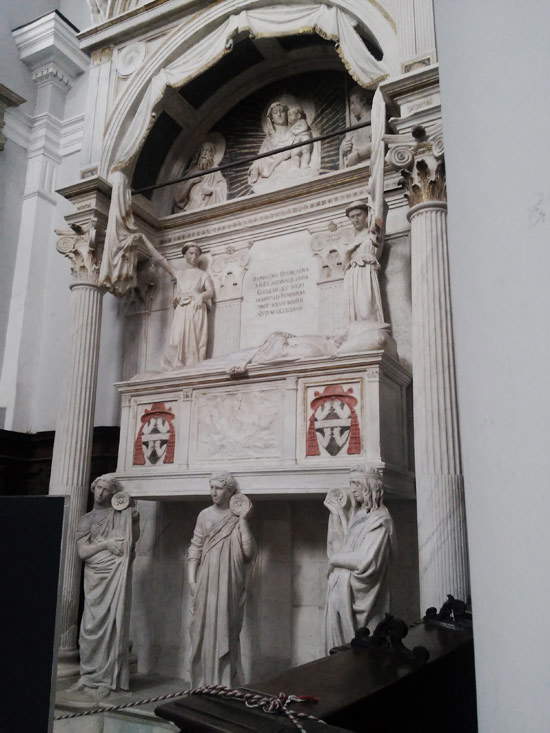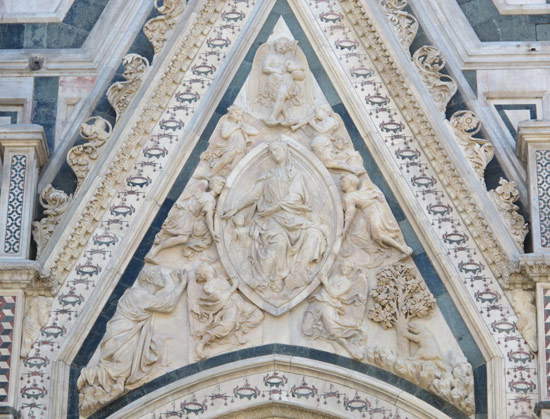In the heart of the cheerful and atmospheric chaos of Spaccanapoli, amidst the inviting scents wafting from doors and windows, the boisterous hubbub of street vendors, and the notes of musicians who pop up from time to time in front of Baroque palaces and often engage passersby in dancing and dancing, lies an unexpected piece of Tuscan Renaissance: it is the tomb of Cardinal Rainaldo Brancaccio, the result of the collaboration of Michelozzo (Florence, 1396 - 1472) and Donatello (Florence, 1386 - 1466). It is located in the splendid church of Sant’Angelo a Nilo, which occupies almost the entirety of one side of Piazzetta Nilo, a widening that rises at the end of Via San Biagio dei Librai: a temple of medieval origin that was extensively remodeled in the early eighteenth century so that it took on the late Baroque forms in which we see it today.
 |
| Facade of the church of Sant’Angelo a Nilo, Naples |
The precious monument that the church preserves inside was designed and sent to Naples between 1426 and 1428. Cardinal Rainaldo Brancaccio (or Brancacci), an influential member of the Neapolitan clergy, had passed away on March 27, 1427, but we know from documents that, by July of that year, about a quarter of the work dedicated to him had been completed: it is therefore safe to assume that the monument was commissioned while the prelate was still alive. It is highly probable that the commissioner of the work was Cosimo de’ Medici, who was appointed executor by Rainaldo Brancaccio himself: both were on close terms with the antipope John XXIII, whose funeral monument (which is in the Florence Baptistery) Donatello and Michelozzo were, at the time, creating. It is therefore entirely likely that the idea of having the two artists also sculpt the monument for Cardinal Brancaccio was born in this context.
Michelozzo, the creator of the structure, imagined the sepulchre with a canopy structure, a feature that still refers to the late Gothic fourteenth-century tradition: however, the work is imbued with features that make it already fit intoRenaissance art. The arch is supported by two Corinthian columns, above which rise two pairs of pilasters flanking the arch: without looking at the statues and the decorative apparatus, these are above all the typically Renaissance elements of the layout. The curtain, which was a typical specification of Gothic tombs, is also reduced to a minimum: we see it hanging from the arch, but it is still insufficient to enclose the space in which the statues of the Madonna and Child and the two saints (Michael and John the Baptist) on either side find their place, and it ends with two simple flaps held up by the two angels placed above the tomb of Cardinal Rainaldo. The latter, in turn held up by three female figures, personifications of the virtues, who act as caryatids, is decorated with the cardinal’s coats of arms and above all with a slab on which Donatello sculpted an Assumption of the Virgin: it is this relief that is the great sculptor’s main work. The structure is completed by a tall mixtilinear cusped pediment, in the center of which we observe the depiction of the Eternal Father flanked by two shells, and at whose sides we find two angels playing the trumpet.
 |
| Michelozzo, Donatello and helpers, Funeral Monument to Cardinal Rainaldo Brancaccio (1426-1428; Carrara marble, height 11.60 m; Naples, Sant’Angelo a Nilo) |
 |
| Detail: the two caryatids and the tomb with Donatello’s Assumption |
In addition to devising the layout of the work, which is made of Carrara marble, Michelozzo is most likely responsible for the figures of the Madonna and Child and the two saints on the sides, as well as the angels holding up the curtain, while the relief with theAssumption is by Donatello, as anticipated, but there are art historians who also glimpse his hand in the caryatids supporting Rainaldo Brancaccio’s tomb, which would also be attributable to Michelozzo’s hand in any case. No one, however, has yet been able to establish with absolute certainty how Michelozzo and Donatello divided the work. And it is equally difficult to identify the contribution of the helpers who collaborated on the undertaking and to whom, according to some scholars(Antonio Natali above all) was assigned a large part of the work, to be conducted on the basis of the drawings made by the two masters. Among those who worked on the monument, it is worth mentioning Pagno di Lapo Portigiani (Fiesole, 1408 - after 1469), often referred to as a co-author of the work, barely eighteen years old at the time: the extent of his intervention, however, is not easy to identify. Instead, it can be said with some margin of certainty that when the work was finished, Pagno Portigiani was in Naples, presumably with Michelozzo, to supervise the assembly and installation of the sepulcher inside the church: the sepulcher had in fact been made entirely in Pisa, the city in which Michelozzo and Donatello had opened a workshop that they conducted together. Moreover, it is likely that Pagno had been given the task of finishing the sculptures once they had been mounted in Naples.
 |
| Donatello, Assumption of the Virgin (1426-1428; Carrara marble, 53.5 x 67 cm; Naples, Sant’Angelo a Nilo, Funeral Monument of Cardinal Rainaldo Brancacci) |
There is a widespread belief that theAssumption is Donatello’s only work in Naples. In fact, another work by Donatello is preserved in the Neapolitan city, the horse’s head most likely intended for a later unfinished monument to Alfonso V of Aragon: it is in the National Archaeological Museum. TheAssumption, however, is the only work by Donatello in Naples that is still in the place for which it was intended (although it is conceivable that originally the tomb of Cardinal Brancaccio occupied a different location within the church: still according to Antonio Natali the work may have been on the apse wall, later demolished). Donatello’s work represents an admirable example of the technique of stiacciato, through which the sculptor gives a sense of depth to the elements of the relief by accentuating or diminishing their thickness in relation to the background in order to communicate their proximity to the observer: in other words, the figures in the foreground will be the most in relief, while the figures further away will be less prominent in relation to the background. Donatello places the assumed Madonna in the center of the relief, seated on a kind of stool covered by a long decorated cloth. Around her, a group of angels begins to carry her to heaven: a sky furrowed by light clouds rendered with short furrows on the marble surface. The Madonna is depicted, very realistically, as an elderly woman: in this way Donatello succeeds in providing an image of the belief (later to become dogma in 1950) that the Madonna was assumed into heaven with body and soul, when she was already well advanced in years. The Tuscan artist depicts her with clasped hands, with an intense expression that communicates to the viewer the strength of her prayer, so strong that she seems almost heedless of the angels who are working briskly around the Virgin, assuming contorted poses, to take her to heaven.
The impression created by the movement of the angels, whose bodies we almost seem to sense the vibrations, is that of a whirling dynamism, and this sensation is accentuated by the fluttering of the angels’ robes themselves and the succession of cirrus we notice in the background. The realistic face of the Madonna and her intense expression, however, anticipate the dramatic tension that would mark several of Donatello’s works made later in his career. This is a profoundly different work from theAssumption by Nanni di Banco (Florence, c. 1380. - 1421), made for the Almond Door of Florence Cathedral, with which it has often been compared: if Nanni di Banco, ten years before Donatello, had set his mandorla (which, compared to Donatello’s rectangular slab, lent itself better to the possibility of suggesting upward movement) on a classical symmetry (and classical, and innovative, was also the fullness of the volumes of the Madonna and angels) in which dynamism was given by the effort of the angels as well as by the robes slightly puffed up by the wind, in Donatello it is up to the convulsive whirling of the protagonists to take on the role of conferring tangible action to the scene.
 |
| Nanni di Banco, Assumption of the Virgin (c. 1414-1420; marble; Florence, Duomo di Santa Maria del Fiore, Porta della Mandorla) - credit |
The novelties of this monument are complemented by the classical suggestions of Michelozzo’s art: it has already been mentioned how dense the structure of the monument is, but the same classicism can be seen in the statues made (in all probability) by the Florentine sculptor and architect. One example: the two outer caryatids, which assume an almost specular pose, may have been inspired (perhaps through the mediation of Lorenzo Ghiberti) by the figure of Iphigenia that appears in a small marble altar, from the first century B.C., now preserved in the Uffizi. Or at least that’s according to the hypothesis of German art historian Richard Krautheimer, who was the first to identify the possible iconographic source: after all, the pose of the two figures, with one arm bent at hip level and the other carried behind the shoulder, is quite identical. Another precedent might be given by the statue of the barbarian prisoner that we see today in Florence under the Loggia dei Lanzi: this is another example of classical art, from the Roman period, dating from the second century AD.
 |
| The right caryatid compared with Iphigenia (detail, 1st century BC; Greek marble, height 65 cm; Florence, Uffizi) and Barbarian prisoner (2nd century AD; Greek marble, height 2.57 m; Florence, Loggia dei Lanzi - credit) |
Remarkable was the impact of such a monument upon its arrival in Naples: indeed, the city had not yet been touched by the innovations of the Renaissance, and the monument to Cardinal Brancaccio thus represents the first Renaissance work in Naples. For this reason, as well as for the high quality of the work, a visit to the church of Sant’Angelo a Nilo is a must for all art lovers coming to the city.
Reference bibliography
Warning: the translation into English of the original Italian article was created using automatic tools. We undertake to review all articles, but we do not guarantee the total absence of inaccuracies in the translation due to the program. You can find the original by clicking on the ITA button. If you find any mistake,please contact us.